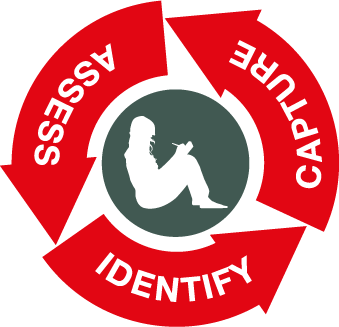
A series of Tricky Topics workshops were conducted with secondary school and college teachers who had a long experience in teaching maths, computing, physics, chemistry and biology in various UK schools, colleges and prisons. The workshops followed the Tricky Topics, three-stage, process of Identify, Capture and Assess. Here is an example of a typical workshop with feedback comments from participants.

Identify
After a brief introduction from the facilitator about the TTT process, the small groups of similar teaching areas, worked collaboratively to agree on a Tricky Topic that caused their students to have major difficulties. The brainstorm activity that followed helped the teachers to break that Tricky Topic down into identifiable parts such as specific student problems. Then, using the Tricky Topic Mapping diagrams, they structured the problems into groups with a common thread. Once each small group completed their diagrams, there was a whole group discussion, led by the facilitator, where each of the groups shared their stumbling blocks and discussed why these are key stumbling blocks.
I think it helps a lot if it’s not your specialism what you are teaching; it helps you understand exactly what they need to know
Marie, chemistry teacher
Breaking down the topic is really useful because it helped us to go straight into the problem and see why it’s there
Claire, biology teacher
I think I had thought about how to teach this, but it (the guide) made me realise that I was missing things that would help students understand
Ann, physics teacher
It’s like you get to realise your own difficulties when it’s not your specialism and through it overcome them so you can help your students understand it better
Marie, chemistry teacher
It’s the most beneficial thing to talk to other people and discuss things and pass ideas backwards and forward, because someone saw something that you’ve probably haven’t or doubted something you have experienced but you couldn’t find a way of doing
Abbi, English teacher
Capture
In this second stage, the teachers, still in their same small groups, input the Tricky Topics and their key Stumbling Blocks to the Tricky Topic tool from the Mapping diagram. Next, they input the specific student problems, linked them to the Stumbling Blocks and, through discussion and with the aid of the problem Distiller, captured the root problems (or WHY their students had these problems). The Tricky Topic tool helped these experienced practitioners to get a complete online picture of their Tricky Topics, Stumbling Blocks and the associated problem examples.
It’s also feeding back to each other because you can see how the problem(s) (examples) are linked to each other
Abbi, English teacher
Without it you don’t get to see how many of the issues (students’ problems) are related to the terminology/language of the subject and how you need to improve that
Mark, maths teacher
You also get to see how their (students) perceptions affect their understanding of the topic
Laura, maths teacher
They (stumbling blocks) lead you to think of alternative ways to support a topic, so that your students can understand it
Abbi, English teacher
From the group discussion you get to see that eventually we are all suffering from the same stumbling blocks, exactly the same
Mark, maths teacher
Assess
Finally, leading on from the capture activities, the small groups guided by the Tricky Topic tool and the facilitator, created quizzes to assess the knowledge in the stumbling blocks and problems. The next stage of this part of the process relies on the teachers themselves to construct an intervention that will tackle one or more of the stumbling blocks.
We do more role playing or storytelling activities, they understood it more, because they could see what it happening rather than doing by the book
Claire, biology teacher
In (the topic of) evaporation I used storyboarding to make them understand… they used pictures and words to create a story
Bill, chemistry teacher
I tend to get them to write the key words, to write some sentences and make a story
Marie, biology Teacher
I‘ll probably have a picture with two things in it to identify what they have in common and how they are different
Claire, biology teacher
It’s quite clever because it let’s you switch the questions in the quiz or add more to assess students’ understanding
Ian, biology teacher
I guess it was educational in more than just a way than maths because like.. it wasn’t maths based originally, there was also using ICT, technology specializing skills
Lizzie, Y8 student (intervention in maths)
You have your own way of doing it and not being told how to do it… you can be more free and more independent and it is more creative and easier
Cora, Y8 student (intervention in maths)
You have to work out the answers yourself
Sapphia, Y7 (intervention in maths)
These workshops proved intense for the experienced teachers because even though they already know what the problems are in their classroom, it pushed them to take a deeper look into these problems and understand why students are having them. That allowed them to think of alternative teaching approaches, methods or intervention to tackle the problem.


